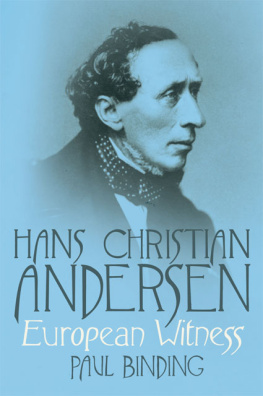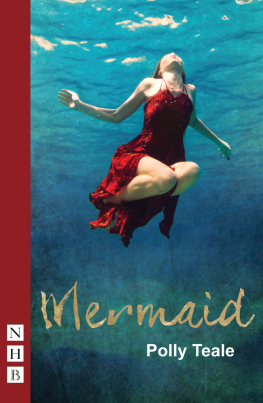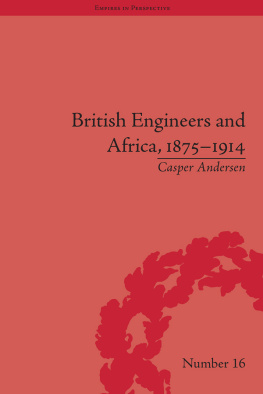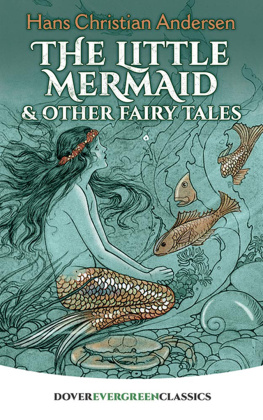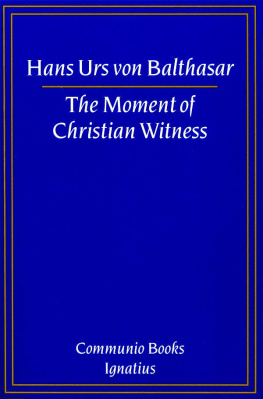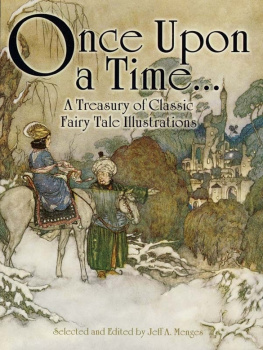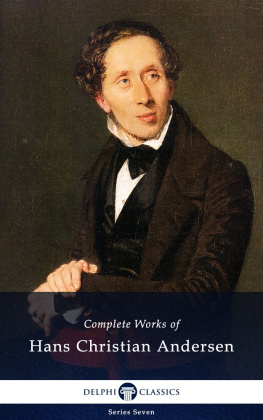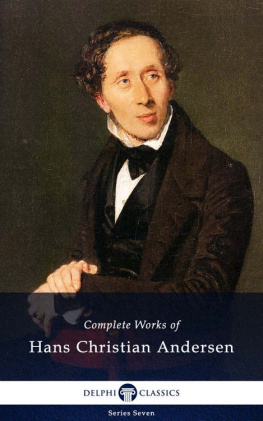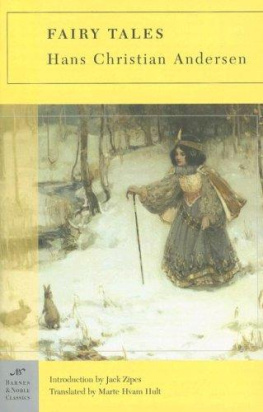
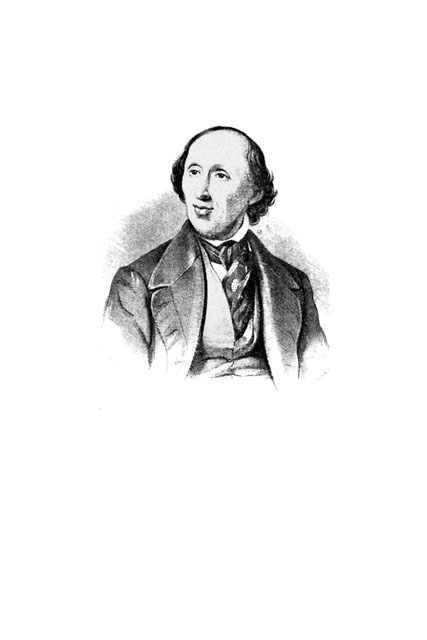

Endpapers: Jumping Pierrot and smiling face, paper cut illustrations by Hans Christian Andersen, reproduced by permission of the Hans Christian Andersen Museum, Odense, Denmark
Frontispiece: engraving of Hans Christian Andersen
Copyright 2014 Paul Binding.
All rights reserved. This book may not be reproduced in whole or in part, in any form (beyond that copying permitted by Sections 107 and 108 of the U.S. Copyright Law and except by reviewers for the public press) without written permission from the publishers.
For information about this and other Yale University Press publications, please contact:
U.S. Office:
Europe Office:
Set in Minion Pro by IDSUK (DataConnection) Ltd
Printed in Great Britain by TJ International Ltd, Padstow, Cornwall
Library of Congress Cataloging-in-Publication Data
Binding, Paul.
Hans Christian Andersen : European Witness / Paul Binding.
pages cm
Includes bibliographical references and index.
ISBN 978-0-300-16923-2 (hardback)
1. Andersen, H. C. (Hans Christian), 1805-1875. 2. Authors, Danish19th centuryBiography. I. Title.
PT8119.B526 2014
839.8136dc23
[B]
2013050567
A catalogue record for this book is available from the British Library.
10 9 8 7 6 5 4 3 2 1
FOR STEIN INVERSEN
A TRUE FRIEND
Contents
PART ONE
PART TWO
Acknowledgements
At Syddansk Universitet (SDU, University of South Denmark) in Odense I must thank Professor (now emeritus) Johan de Mylius, Andersen expert and critic, for the generous time he has spent talking to me in the most stimulating and informative way. He also invited me to give two lectures of my own choosing at the Hans Christian Andersen Centre there, one on The Improvisatore, the other on The Ice Maiden; these contributed substantially to the chapters in this book. Also in Odense I profited greatly from the knowledge and friendliness of the Director of the Hans Christian Andersen Museum, Ejnar Stig Askgaard. At SDU the Professor of American Literature, Jan Nordby Gretlund took a personal interest in my work, and kindly drove me to see places on Fyn and Langeland with Andersen connections; these enriched my appreciation immeasurably.
The Cultural Attach at the Royal Danish Embassy in London, Lone Britt Christensen has been tirelessly helpful to me over the years, with introductions and practical suggestions. Through her I met Annette Bach of the Danish Arts Council who took an interest in my work, leading to handsome grants of inestimable help to me. I must also give heartfelt thanks to Dr Jakob Stougaard-Nielsen, Senior Lecturer in Scandinavian Literature at UCL School of European Language, Culture and Society for checking my Danish quotations and material.
At Yale University Press I must first thank its Managing Director, Robert Baldock, who commissioned this book, playing a most creative part in its whole evolution. To Managing Editor Candida Brazil, Assistant Editor Tami Halliday, both at Yale, and to my painstaking copy-editor and proofreader, Beth Humphreys and Loulou Brown I owe inexpressibly much. Also to Jane Horton whose index is a model of thoughtfulness and sensitivity to my text.
I also must include in my gratitude my friend and neighbour in Shropshire, Carol Wright, for unflagging assistance with the original typescript, especially over superscript numbering. And also of course my agent Christopher Sinclair-Stevenson who has always understood my hopes and intentions in addition to my actual published work.
In Hans Christian Andersen: European Witness I have made my own translations of all quotations from its subject's imaginative work. For his non-fiction I have relied on the best obtainable translations of others (impossible to find a satisfactory one in the case of A Poet's Bazaar). I therefore owe a particular debt to Eric Lane of Dedalus for making accessible to me, at some trouble to himself, the text of W. Glyn Jones's new revised translation of My Fairy-Tale Life.
I want also to acknowledge the help of the London Library and of the Royal Literary Fund; Eileen Gunn at the latter has been responsible for the easing of my working life. This last has benefited enormously too by my regular dealings with the Times Literary Supplement and the Independent, dealings which also assist a writer's sense of identity. In this context too I must mention Christopher MacLehose, great friend to European literature and a helpful mentor to myself.
Introductory: Europe, Denmark, the World
Europe and Denmark Andersen's work is born of the relationship between the two, and his own relation to both. If, during important years of his life, Andersen had to look outside Denmark for the degree of appreciation he felt his due, if his creative mind was constantly sharpened by travel, by encounters with European writers, his own art owed quite inestimably to Danish tradition, to Danish artists and pundits of the Golden Age, and to the Danish language itself, its characteristic rhythms and idioms. Conversely, while much of the appeal of his writings (and of his own personality), both at home and abroad, depended on his Danish provenance a freshness, an intelligence comparatively free of dogmatic or political alignments, the factions and commercialism of elsewhere it is also the case that they were admired, even loved, because they articulated the tensions and hopes, the trials and satisfactions, of a whole continent undergoing re-formation.
On 26 January 1852 the newspaper Fdrelandet (The Fatherland) featured Svanereden (The Swan's Nest) dealing with Denmark itself, its distinguished past, its present difficulties, its survival in increasingly uncertain times.
The last few years had been peculiarly testing ones for Denmark. Between 1848 and 1850 the country from 1849 a Constitutional and not, as it had been since 1660, an Absolute Monarchy was engulfed by Trerskrigen,
The opening sentence of Thousands of Years to Come introduces hordes of young Americans regularly travelling over the Atlantic to Europe, through the air on wings of steam. An airship is crowded with passengers living up to their favourite book, Europa set i otte Dage (Europe seen in eight days). Thanks to the electromagnetic wire beneath the sea they have all telegraphed their hotel reservations in advance. The first country they see below them is Ireland, but they go on sleeping until above England, their first stop: Shakespeare's land to the more cultured, the land of politics or machines to the others. This first day of their European tour takes in Scotland as well as England, after which they proceed via the Channel Tunnel to France, which gave the world Charlemagne, Molire, Napoleon. By this unspecified date, observes Andersen, many illustrious French men and women whose names we do not know will have been born in Europe's Crater, Paris. And thence to Spain which still corresponds to the old images, with beautiful dark-eyed women and ballad-singers extolling El Cid.
Next they travel through the air to Italy, and here we readers are in for a grim surprise. The Eternal City of Rome no longer exists; only one wall of St Peter's stands, and the authenticity of that is in doubt. The Campagna the countryside round Rome so esteemed by nineteenth-century painters has become a desert. Many readers would have recalled the rich evocations of Italy in Andersen's first novel,
Next page
